
Catapult Run, subtitled "A Race of Epic Proportions", is a fantasy role-playing game adventure published by Fantasy Factory in 1984.

Catapult Run, subtitled "A Race of Epic Proportions", is a fantasy role-playing game adventure published by Fantasy Factory in 1984.
The adventure is set in the World of Cypher. Thematically similar to the contemporaneous movie The Cannonball Run (1981), the player characters are participating in a five-team race held only once every seven years. To win, the characters must traverse 600 miles of wilderness, overcoming geographical obstacles, combat with the other teams, and ravenous monsters, in order to be the first to reach the City of Cypher and place a crystal orb in the crown of King Kornilian. [1] Although spellcasting is allowed during the race, no teleportation magic can be used.

Catapult Run was designed by Joe Thwaites, Chris Abbott, and Ian Hartshorn, with interior art by Colin Nordel and Ken Broad, cover art by Jeff Lowe, Chris Abbott, and Colin Nordel, and cartography by Stephen Mortimer. [2] The appendix includes weather conditions for each day of the race, pre-generated characters, and optional overland movement rules. [1] Both editions were published by Canadian publisher Fantasy Factory in 1984. [3]
The adventure is played using the rules of Advanced Dungeons & Dragons published by TSR, Inc. Fantasy Factory, a Canadian publisher based in Brampton, Ontario, had no connection to TSR, and its use of the AD&D rules was unlicensed. The first sentence of the introduction to this adventure claimed "This is the first in a group of modules, each of which can be played on its own or as part of the series", but no further adventures were ever published. [2]
The first edition (1984) is a 44-page saddle-stapled digest-sized softcover book that has a simple grey and red cover with a black & white illustration. The inside front cover has a pocket that holds a 28-page map booklet, an errata sheet and an 8-page illustration booklet. [4]
The second edition (also 1984) is a 32-page saddle-stapled softcover book featuring a much more professional four-colour bi-fold cover. [2]
In the June 1985 edition of Space Gamer (Issue No. 74), Allen Varney called the writing "clear and professional", but thought the art was "bad or dull, or both." Varney found the various encounters to be "complete and sometimes imaginative", and the new rules for drowning and overland travel "intelligent". But Varney was ambivalent about this adventure, saying, "I think most adventurers would want a more coherent approach. The race is a flimsy device for stringing together a batch of completely unrelated encounters." He concluded, "Catapult Run is a respectable product, but it lacks imagination, replay value – the race is run once every seven years – and a useful story line. Whether it might have been improved had TSR authorized and supervised its production is problematic. Anyway, it's okay for a first effort." [1]

Arduin is a fictional universe and fantasy role-playing system created in the mid-1970s by David A. Hargrave. It was the first published "cross-genre" fantasy RPG, with everything from interstellar wars to horror and historical drama, although it was based primarily in the medieval fantasy genre.

Expedition to the Barrier Peaks is a 1980 adventure module for the Dungeons & Dragons role-playing game written by Gary Gygax. While Dungeons & Dragons (D&D) is typically a fantasy game, the adventure includes elements of science fiction, and thus belongs to the science fantasy genre. It takes place on a downed spaceship; the ship's crew has died of an unspecified disease, but functioning robots and strange creatures still inhabit the ship. The player characters fight monsters and robots, and gather the futuristic weapons and colored access cards that are necessary for advancing the story.

Talislanta is a fantasy role-playing game written by Stephen Michael Sechi and published by Bard Games in 1987. There have been six different English-language editions and several foreign language editions published. All English-language products of Talislanta are now freely available via a Creative Commons licence.

To Find a King is an adventure module for the first edition of the Advanced Dungeons & Dragons fantasy role-playing game. It was written by Bob Blake and published in 1985 by TSR. As part of the Competition, or C-series of modules, it contains material that was first used as a tournament adventure at Gen Con XVI. The module is designed for a party of ten characters at levels 4–7 and can be run as either a competition module or as part of a campaign.
The DL series is a series of adventures and some supplementary material for the Advanced Dungeons & Dragons role playing game. These modules along with the Dragonlance Chronicles trilogy of novels, which follow one possible adventure series through the modules, were the first published items that established the Dragonlance fictional universe. The original DL series was released from 1984 to 1986, with the final two modules added to it in 1988. In the 1990s these roleplaying adventures from the original series were collected and revised for 2nd Edition AD&D as the three DLC Dragonlance Classics modules. There were also versions of the module series released in 1999, 2000 and 2006.
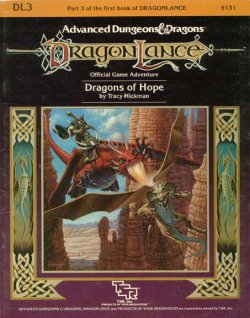
Dragons of Hope is an adventure in the Dungeons & Dragons fantasy role-playing game. It is the third module of the 14 Dragonlance adventures published by TSR, Inc., between 1984 and 1986. The module is intended for level 6-8 player characters.

Conan Against Darkness! is a 1984 adventure module for the first edition of the Advanced Dungeons & Dragons fantasy roleplaying game, set in the Hyborian universe of Robert E. Howard's character Conan the Barbarian. It is designed for four player characters at character level 10-14 and uses some minor rule variations in an attempt to recreate the setting's atmosphere. It was publicized as containing a "journey of epic proportions".
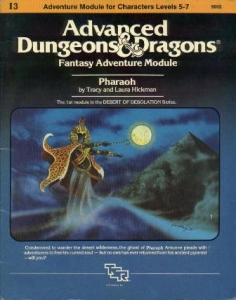
Desert of Desolation is a compilation adventure module published by TSR for the Dungeons & Dragons (D&D) fantasy roleplaying game. It combines three previously published individual modules: Pharaoh, Oasis of the White Palm, and Lost Tomb of Martek. The modules were made for use with the first edition Advanced Dungeons & Dragons (AD&D) rules. Pharaoh was created by Tracy and Laura Hickman soon after the couple married in 1977, and published by TSR in 1982. Oasis of the White Palm was a collaboration between Tracy Hickman and Philip Meyers, and Hickman wrote the Lost Tomb of Martek on his own; both were printed in 1983.

The Veiled Society is an adventure module for the Basic Rules of the Dungeons & Dragons fantasy role-playing game published in 1984. The adventure's product designation is TSR 9086.

The Dungeons & Dragons Basic Set is a set of rulebooks for the Dungeons & Dragons (D&D) fantasy role-playing game. First published in 1977, it saw a handful of revisions and reprintings. The first edition was written by J. Eric Holmes based on Gary Gygax and Dave Arneson's original work. Later editions were edited by Tom Moldvay, Frank Mentzer, Troy Denning, and Doug Stewart.
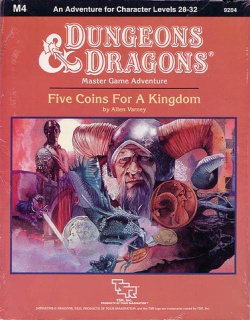
Five Coins for a Kingdom is an adventure module for the Dungeons & Dragons fantasy role-playing game, set in that game's Mystara campaign setting. TSR, Inc. published the module in 1987 for the D&D Master Set rules. It is part of the "M" series of modules. The module was designed by Robin Jenkins. Its cover art and interior art is by John and Laura Lakey, and cartography by William Reuter.

Arabian Adventures is an accessory for the 2nd edition of the Advanced Dungeons & Dragons fantasy role-playing game, published in 1992.

Mountain of Mystery is a role-playing game adventure published by Dimension Six in 1980.
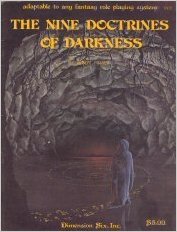
The Nine Doctrines of Darkness is a fantasy role-playing game adventure and setting published by Dimension Six in 1980.
The Island of Doctor Apocalypse is an adventure published by Fantasy Games Unlimited (FGU) in 1982 for the superhero role-playing game Villains and Vigilantes.
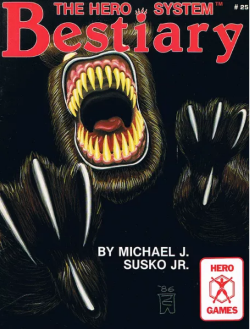
The Hero System Bestiary is a supplement published by Hero Games in 1986 to provide a variety of creatures for superhero, espionage and fantasy role-playing games that use the Hero System rules. As new editions of the Hero System rules were published, new editions of the Bestiary were also published.

Blood Brothers is a light-hearted anthology of short adventures published by Chaosium in 1990 for the Lovecraftian horror role-playing game Call of Cthulhu.

The Halls of the Dwarven Kings is an adventure published by Integrated Games in 1984 for any role-playing game system.

Street Samurai Catalog is a supplement published by FASA in 1989 for the near-future cyberpunk role-playing game Shadowrun.

Warboid World is a play-by-mail game originally published and moderated by Adventures by Mail in 1983 in which players build up armies of robots and send them to destroy other players' robot factories.